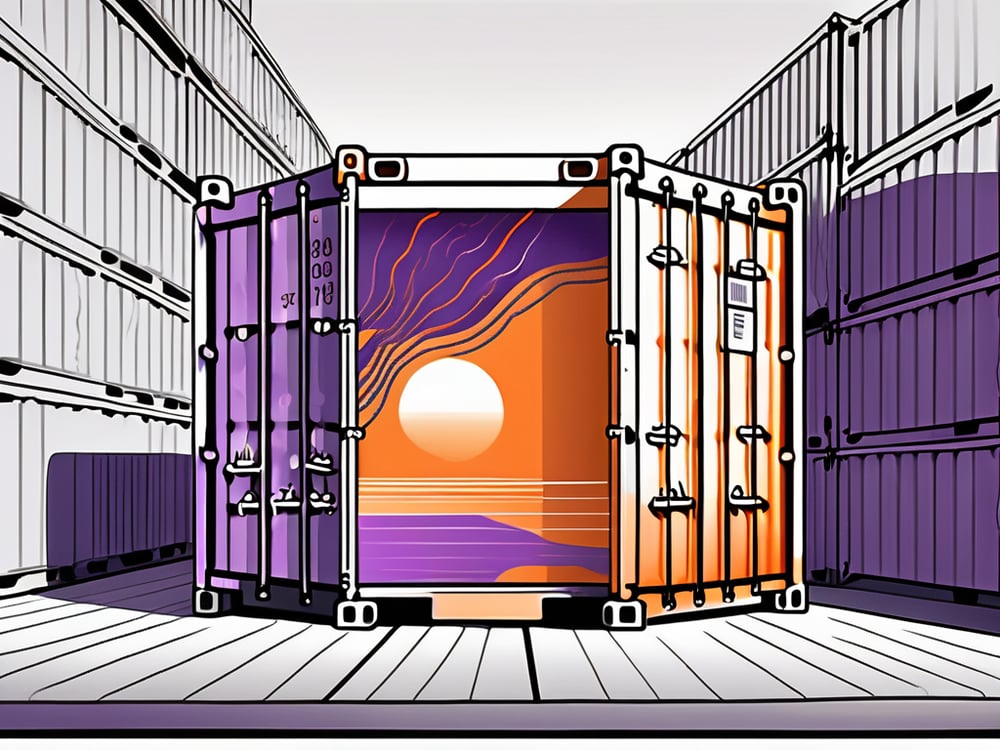Did you know that shipping containers can get scorching hot? These metal giants, used to transport goods across the world, can reach temperatures that can rival the sun’s surface.
In this article, we will discuss about:
- The impact of external conditions on container heat
- How heat accumulates in shipping containers
- Material and design considerations
- Risks of high temperatures
- Mitigating heat
Table of Contents
ToggleExtremely Hot Temperatures Shipping Containers Can Reach and the Role of External Factors
External conditions play a significant role in determining how hot a shipping container can get. On land, temperatures inside shipping containers can range from as low as -21ºF (-29ºC) to as high as 135 degrees Fahrenheit (57ºC), with the greatest temperature fluctuations occurring on land. Let’s explore two key influencers in more detail.
Role of Ambient Temperature
The surrounding air temperature can greatly impact container heat. In scorching desert regions, where the mercury rises to staggering heights, containers face an uphill battle in maintaining a comfortable interior temperature for their contents. Businesses that rely on 3PL services in the USA must factor in temperature-sensitive shipping solutions to prevent damage to delicate cargo.
Furthermore, the ambient temperature not only affects the initial heat inside the container but also plays a crucial role in the rate at which heat dissipates. In extreme heat, containers struggle to cool down even during the night, leading to prolonged exposure to high temperatures that can damage sensitive cargo.
Effect of Sunlight Exposure
Sunlight can be both a blessing and a curse for shipping containers. While it provides much-needed energy for plants and humans alike, the sun’s rays can cause containers to heat up rapidly. Dark-colored containers absorb more sunlight, further exacerbating the rise in temperature.
Moreover, prolonged exposure to direct sunlight can result in uneven heating within the container, creating hot spots that may compromise the integrity of certain goods. Insulation plays a critical role in mitigating the effects of sunlight exposure, as well-designed insulation can help regulate internal temperatures and protect sensitive cargo from heat-related damage.
How Heat Accumulation Builds Up in Shipping Containers
When it comes to container heat, several factors come into play. Let’s take a closer look at what influences the temperature inside these metal behemoths.
Shipping containers, commonly used for transporting goods across long distances, are susceptible to heat accumulation due to various factors. Understanding how heat builds up within these containers is crucial for maintaining the quality of goods during transit.
Factors Influencing Container Temperature
Container temperature can be affected by various factors, including:
- Ambient Temperature
- Sunlight Exposure
Ambient temperature plays a significant role in determining the heat levels inside a shipping container. In hot climates, the surrounding air can quickly raise the temperature inside the container, especially if proper ventilation is lacking.
On the other hand, in colder environments, heat retention becomes crucial to prevent goods from freezing during transport.
The Science Behind Heat Build-up
Container heat is a result of the greenhouse effect—a phenomenon in which the sun’s rays penetrate the container but struggle to escape, leading to temperature build-up. The metal structure of the container retains and amplifies this heat, creating a warm environment inside.
Sunlight exposure is another critical factor contributing to heat accumulation in shipping containers. Learn more about how to prevent cargo damage during transit and how to minimize heat-related risks. When containers are left in direct sunlight for extended periods, the metal surfaces absorb and radiate heat, elevating the internal temperature significantly.
This effect is particularly pronounced in regions with high solar radiation, emphasizing the need for proper insulation and shading to mitigate heat build-up.
Material and Design Considerations in Shipping Containers
Container material and design play a crucial role in determining how much heat is retained. Let’s explore these factors in more detail.

When considering the material of shipping containers, it is essential to understand the impact it has on heat retention. Steel, commonly used in container construction, has high thermal conductivity.
This means that steel containers can easily absorb and transfer heat, leading to temperature fluctuations. On the other hand, materials like composite alloys offer lower thermal conductivity, providing better insulation against external temperature changes.
Influence of Container Material on Heat Retention
The material used in the construction of shipping containers can significantly impact their ability to retain heat. Materials such as steel have high thermal conductivity, meaning they absorb and transfer heat more easily. In contrast, composite materials with lower thermal conductivity can help mitigate temperature fluctuations.
Moreover, the thickness of the container material also plays a crucial role in heat retention. Thicker walls provide better insulation, reducing heat transfer between the interior and exterior of the container. This is particularly important for shipping goods that are sensitive to temperature variations.
Design Features That Affect Container Temperature
Container design also plays a vital role in heat management. Features such as insulation, ventilation systems, and reflective coatings can help regulate temperatures within the container. By incorporating these design elements, companies can mitigate the risks associated with extreme heat.
Insulation is a key design feature that helps in maintaining consistent temperatures within shipping containers. Materials like foam insulation or thermal liners can prevent heat loss or gain, ensuring that the goods inside are protected from external temperature changes.
Additionally, ventilation systems aid in air circulation, preventing heat buildup in confined spaces. Reflective coatings on the exterior of containers can also deflect sunlight, reducing heat absorption and keeping the interior cooler.
Potential Risks of High Temperatures
High temperatures in shipping containers pose various risks, which we will explore in this section. Read the biggest challenges in freight shipping to understand how extreme conditions affect supply chains. It is essential to consider the impact of high temperatures on different types of goods during transportation.
For example, perishable foods are particularly vulnerable to heat, as prolonged exposure can lead to spoilage and contamination.
Electronics are also at risk, as extreme temperatures can cause malfunctions or even permanent damage. Additionally, certain chemicals may become unstable and hazardous when exposed to excessive heat, increasing the potential for accidents during transit.
Implications for Shipped Goods
The high temperatures experienced inside shipping containers can have a detrimental impact on the goods being transported.
Companies shipping fragile or perishable items can benefit from temperature-controlled fulfillment to ensure product integrity. Items such as perishable foods, electronics, and certain chemicals can sustain damage or spoilage if exposed to excessive heat for prolonged periods.
Furthermore, the effects of high temperatures on goods can extend beyond physical damage. For instance, heat can accelerate the degradation of certain materials, reducing the shelf life and overall quality of products. This can result in financial losses for businesses and dissatisfied customers receiving compromised goods.
Health and Safety Concerns
Excessive heat in shipping containers not only affects the goods but also poses health and safety risks to workers. Temperature-sensitive cargo can emit harmful gases or become volatile at high temperatures, posing potential hazards to those handling these containers.
Moreover, the combination of high temperatures and hazardous materials in shipping containers can create a challenging environment for workers.
Proper ventilation and safety protocols are crucial to mitigate the risks of exposure to toxic fumes or substances that may leak or react due to heat, ensuring the well-being of personnel involved in the transportation and handling of such cargo.
Mitigating Heat in Shipping Containers
The shipping industry has made significant strides in finding solutions to mitigate heat in containers. Let’s explore some of these innovations.
Ventilation and Insulation Solutions
A well-ventilated container can help dissipate heat, creating a more comfortable environment for the goods inside. Insulation materials, such as foam or fiberglass, can minimize heat transfer from the container’s exterior to its interior, reducing the risk of overheating. Businesses handling temperature-sensitive goods should explore climate-controlled warehousing to prevent product damage.
Proper ventilation is crucial in ensuring that the temperature inside a shipping container remains stable. Ventilation systems can include strategically placed vents or fans that help circulate air and prevent heat buildup. Additionally, insulation plays a key role in maintaining a consistent temperature by acting as a barrier against external heat sources.
Technological Innovations for Temperature Control
Advancements in technology have paved the way for temperature control systems in shipping containers. These cutting-edge solutions monitor and adjust internal temperatures, ensuring that goods remain within the optimal range throughout their journey.
Temperature control technology has revolutionized the way goods are transported, especially those sensitive to heat. These systems can be programmed to activate cooling mechanisms when temperatures rise above a certain threshold, safeguarding the quality and integrity of the cargo.
Temperature Control Technology in Shipping Containers Helps Mitigate Heat
So, the next time you see a shipping container on the road, you’ll know that inside, temperatures may be soaring. Thanks to a better understanding of heat accumulation, improved container design, and innovative temperature control systems, the shipping industry is bringing the heat under control—keeping goods safe and passengers cool. For businesses looking to optimize their shipping and fulfillment processes, Fulfyld provides tailored logistics solutions to ensure efficiency and reliability.






